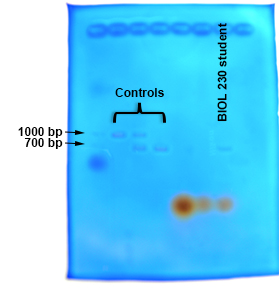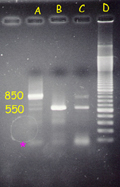|
This page is designed to help you interpret your experimental results.
Try a real application of PCR
to diagnose a disease.
Do you need to review Hardy-Weinberg?
BioScience article
About quaggas.
|
|
Results
 |
Samples
from three different students are in lanes A, B, and C. The size
ladder in D is in 100 bp increments (100, 200, 300, etc.)
Which student sample is homozygous for
alu 550 bp? For alu 850 bp? Heterozygous for the
two alu alleles?
|
| *Primer-dimer
artifacts: the primers can sometimes anneal to themselves and create
small templates for PCR amplification - these are the so-called
primer-dimer artifacts. |
The following data are for alu alleles: A and B. You can be
homozygous for 200, homozygous for 500, or heterozygous. There are two
alleles for gene A: 200 bp and 500 bp; and for gene B: 100 bp and 400
bp.
Class Data
| Genotype |
715/715 |
715/415 |
415/415 |
| Number |
9 |
5 |
5 |
| |
p2 |
2pq |
q2 |
Actual |
13 (0.41) |
17 (0.53) |
2 (0.06) |
Expected |
0.56 |
0..38 |
0.06 |
1. Do you think Alu is useful for distinguishing people
in this class?
2. Would it matter if the two samples came from people
who were closely related?
3. If the two genotypes were the same would that prove
that the samples came from the same person?
4. If the PIC for the selected population and the Hardy-Weinberg
population are different. What is the significance of this?
|




